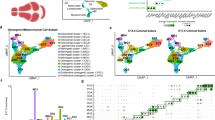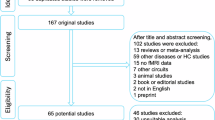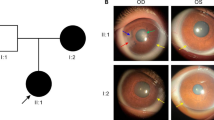Abstract
The Saethre–Chotzen syndrome (SCS) is an autosomal dominant craniosynostosis syndrome with uni- or bilateral coronal synostosis and mild limb deformities. It is caused by loss-of-function mutations of the TWIST 1 gene. In an attempt to delineate functional features separating SCS from Muenke's syndrome, we screened patients presenting with coronal suture synostosis for mutations in the TWIST 1 gene, and for the Pro250Arg mutation in FGFR3. Within a total of 124 independent pedigrees, 39 (71 patients) were identified to carry 25 different mutations of TWIST 1 including 14 novel mutations, to which six whole gene deletions were added. The 71 patients were compared with 42 subjects from 24 pedigrees carrying the Pro250Arg mutation in FGFR3 and 65 subjects from 61 pedigrees without a detectable mutation. Classical SCS associated with a TWIST 1 mutation could be separated phenotypically from the Muenke phenotype on the basis of the following features: low-set frontal hairline, gross ptosis of eyelids, subnormal ear length, dilated parietal foramina, interdigital webbing, and hallux valgus or broad great toe with bifid distal phalanx. Functional differences were even more important: intracranial hypertension as a consequence of early progressive multisutural fusion was a significant problem in SCS only, while mental delay and sensorineural hearing loss were associated with the Muenke's syndrome. Contrary to previous reports, SCS patients with complete loss of one TWIST allele showed normal mental development.
Similar content being viewed by others
Log in or create a free account to read this content
Gain free access to this article, as well as selected content from this journal and more on nature.com
or
References
Saethre H : Ein Beitrag zum Turmschädelproblem. (Pathogenese, Erblichkeit und Symptomatologie.). Dtsch Z Nervenheilk 1931; 117: 533–555.
Chotzen F : Eine eigenartige familiäre Entwicklungsstörung. (Akrocephalosyndaktylie, Dystosis craniofacialis und Hypertelorismus.). Monatsschr Kinderheilk 1933; 55: 97–122.
Friedman JM, Hanson JW, Graham B, Smith DW : Saethre–Chotzen syndrome: a broad and variable pattern of skeletal malformations. J Pediatr 1977; 91: 929–933.
Reardon W, Winter RM : Saethre–Chotzen syndrome. J Med Genet 1994; 31: 393–396.
Howard TD, Paznekas WA, Green ED et al: Mutations in TWIST, a basic helix–loop–helix transcription factor, in Saethre–Chotzen syndrome. Nat Genet 1997; 15: 36–41.
El Ghouzzi V, Le Merrer M, Perrin-Schmitt F et al: Mutations of the TWIST gene in the Saethre–Chotzen syndrome. Nat Genet 1997; 15: 42–46.
Gripp KW, Zackai EH, Stolle CA : Mutations in the human TWIST gene. Hum Mutat 2000; 15: 150–155.
Yousfi M, Lasmoles F, Lomri A, Delannoy P, Marie PJ : Increased bone formation and decreased osteocalcin expression induced by reduced Twist dosage in Saethre–Chotzen syndrome. J Clin Invest 2001; 107: 1153–1161.
Jabs EW : A TWIST in the fate of human osteoblasts identifies signaling molecules involved in skull development. J Clin Invest 2001; 107: 1075–1077.
Wilkie AO, Morris-Kay GM : Genetics of craniofacial development and malformation. Nat Rev Genet 2001; 2: 458–468.
Sosic D, Richardson JA, Yu K, Ornitz DM, Olson EN : TWIST regulates cytokine gene expression through a negative feedback loop that represses NF-kappaB activity. Cell 2003; 112: 169–180.
Castanon I, Bayliss MK : A Twist in fate: evolutionary comparison of Twist structure and function. Gene 2002; 287: 11–22.
Bialek P, Kern B, Yang X et al: A twist code determines the onset of osteoblast differentiation. Dev Cell 2004; 6: 423–435.
El Ghouzzi V, Lajeunie E, Le Merrer M et al: Mutations within or upstream of the basic helix–loop–helix domain of the TWIST gene are specific to the Saethre–Chotzen syndrome. Eur J Hum Genet 1999; 7: 27–33.
Bellus GA, Gaudenz K, Zackai EH : Identical mutations in three different fibroblast growth factor receptor genes in autosomal dominant craniosynostosis syndromes. Nat Genet 1996; 14: 174–176.
Muenke M, Gripp KW, McDonald-McGinn DM : A unique point mutation in the fibroblast growth factor receptor 3 gene (FGFR3) defines a new craniosynostosis syndrome. Am J Hum Genet 1997; 60: 555–564.
Paznekas WA, Cunningham ML, Howard TD et al: Genetic heterogeneity of Saethre–Chotzen syndrome, due to TWIST and FGFR mutations. Am J Hum Genet 1998; 62: 1370–1380.
Kress W, Collmann H, Büsse M, Halliger-Keller B, Mueller CR : Clustering of FGFR2 gene mutations in patients with Pfeiffer and Crouzon syndromes (FGFR2-associated craniosynostosis). Cytogenet Cell Genet 2000; 91: 134–137.
Renier D, El Ghouzzi V, Bonaventure J, Le Merrer M, Lajeunie E : Fibroblast growth factor receptor 3 mutation in nonsyndromic coronal synostosis: clinical spectrum, prevalence, and surgical outcome. J Neurosurg 2000; 92: 631–636.
Pantke OA, Cohen MM, Witkop CJ : The Saethre–Chotzen syndrome. Birth Defects 1975; 11: 190–225.
Cohen MM : Saethre–Chotzen syndrome; in Cohen MM, MacLean RE (eds): Craniosynostosis – diagnosis, evaluation, and mangement. New York, 2000, chapter 28, pp 374–376.
Trusen A, Beissert M, Collmann H, Darge K : The pattern of skeletal anomalies in the cervical spine, hands and feet in patients with Saethre–Chotzen syndrome and Muenke-type mutation. Pediatr Radiol 2003; 33: 168–172.
Prader A, Largo RH, Molinari L, Issler C : Physical growth of Swiss children from birth to 20 years of age. Helvet Paediatr Acta Suppl 1989; 52: 1–125.
Hall JG, Froster-Iskenius UG, Allanson JE : Handbook of normal physical measurements. Oxford: Oxford University Press, 1989.
Elanko N, Sibbring JS, Metcalfe KA : A survey of TWIST for mutations in craniosynostosis reveals a variable length polyglycine tract in asymptomatic individuals. Hum Mutat 2001; 18: 535–541.
Cai J, Shoo BA, Sorauf T, Jabs EW : A novel mutation in the TWIST gene, implicated in Saethre–Chotzen syndrome, is found in the original case of Robinow–Sorauf syndrome. Clin Genet 2003; 64: 79–82.
Ibrahimi OA, Zhang F, Eliseenkova AV, Linhardt RJ, Mohammadi M : Proline to arginine mutations in FGF receptors 1 and 3 result in Pfeiffer and Muenke craniosynostosis syndromes through enhancement of FGF binding affinity. Hum Mol Genet 2004; 13: 69–78.
Gripp KW, Stolle CA, Celle L et al: TWIST gene mutation in a patient with radial aplasia and craniosynostosis: further evidence for heterogeneity of Baller–Gerold syndrome. Am J Med Genet 1999; 82: 170–176.
Kunz J, Hudler M, Fritz B : Identification of a frameshift mutation in the gene TWIST in a family affected with Robinow–Sorauf syndrome (letter). J Med Genet 1999; 36: 650–652.
Seto ML, Lee SJ, Sze RW, Cunningham ML : Another TWIST on Baller–Gerold syndrome. Am J Med Genet 2001; 104: 323–330.
Kopysz Z, Statiska M, Rysko I, Kulzyk B : The Saethre–Chotzen syndrome with partial bifid of the distal phalanges of the great toes. Hum Genet 1980; 56: 195–204.
Renier D, Arnaud E, Cinalli G et al: Prognosis for mental function in Apert's syndrome. J Neurosurg 1996; 85: 66–72.
Johnson D, Horsley SW, Moloney DM et al: A comprehensive screen for TWIST mutations in patients with craniosynostosis identifies a new microdeletion syndrome of chromosome band 7p21.1. Am J Hum Genet 1998; 63: 1282–1293.
Cai J, Goodman BK, Patel AS et al: Increased risk for developmental delay in Saethre–Chotzen syndrome is associated with TWIST deletions: an improved strategy for TWIST mutation screning. Hum Genet 2003; 114: 68–76.
Lee S, Seto M, Sie K, Cunningham M : A child with Saethre–Chotzen syndrome, sensorineural hearing loss, and a TWIST mutation. Cleft Palate Craniofac J 2002; 39: 110–114.
Goriely A, McVean GAT, Röjmyr M, Ingemarsson B, Wilkie AOM : Evidence for selective advantage of pathogenic FGFR2 mutations in the male germ line. Science 2003; 301: 643–646.
den Dunnen JT, Antonarakis SE : Mutation nomenclature extensions and suggestions to describe complex mutations: a discussion. Hum Mutat 2000; 20: 7–12.
Acknowledgements
We thank all patients and their families as well as the ‘Elterninitiative Apert-Syndrom’ for supporting this study, and Birgit Halliger-Keller and Olga Kari for excellent technical assistance.
Author information
Authors and Affiliations
Corresponding author
Rights and permissions
About this article
Cite this article
Kress, W., Schropp, C., Lieb, G. et al. Saethre–Chotzen syndrome caused by TWIST 1 gene mutations: functional differentiation from Muenke coronal synostosis syndrome. Eur J Hum Genet 14, 39–48 (2006). https://doi.org/10.1038/sj.ejhg.5201507
Received:
Revised:
Accepted:
Published:
Issue date:
DOI: https://doi.org/10.1038/sj.ejhg.5201507
Keywords
This article is cited by
-
Deviating dental arch morphology in mild coronal craniosynostosis syndromes
Clinical Oral Investigations (2019)
-
Destabilization of the TWIST1/E12 complex dimerization following the R154P point-mutation of TWIST1: an in silico approach
BMC Structural Biology (2018)
-
RETRACTED ARTICLE: Fetal methotrexate syndrome and Antley–Bixler syndrome should not be confused
Pediatric Radiology (2018)
-
Craniosynostosis as a clinical and diagnostic problem: molecular pathology and genetic counseling
Journal of Applied Genetics (2018)



